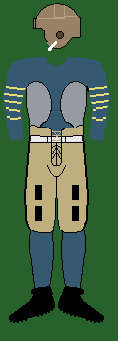1917 Michigan Wolverines football team
Week 1: Case at Michigan
|
1 |
2 |
3 |
4 |
Total |
| Case |
0 |
0 |
0 |
0 |
0 |
| Michigan |
|
|
|
|
0 |
|
Week 2: Kalamazoo Normal at Michigan
|
|
Week 3: Mount Union at Michigan
|
1 |
2 |
3 |
4 |
Total |
| Mount Union |
0 |
0 |
0 |
0 |
0 |
| • Michigan
|
7 |
28 |
28 |
6 |
69 |
|
Week 4: Detroit at Michigan
|
1 |
2 |
3 |
4 |
Total |
| Detroit |
0 |
0 |
3 |
0 |
3 |
| • Michigan
|
0 |
7 |
7 |
0 |
14 |
|
Week 5: Michigan Agricultural at Michigan
|
|
Week 6: Nebraska at Michigan
|
1 |
2 |
3 |
4 |
Total |
| Nebraska |
0 |
0 |
0 |
0 |
0 |
| • Michigan
|
7 |
7 |
3 |
3 |
20 |
|
Week 7: Kalamazoo at Michigan
|
1 |
2 |
3 |
4 |
Total |
| Kalamazoo |
0 |
0 |
0 |
0 |
0 |
| • Michigan
|
14 |
21 |
13 |
14 |
62 |
|
Week 8: Cornell at Michigan
|
1 |
2 |
3 |
4 |
Total |
| Cornell |
0 |
0 |
0 |
0 |
0 |
| • Michigan
|
14 |
21 |
13 |
14 |
62 |
|
The 1917 Michigan Wolverines football team represented the University of Michigan in the 1917 college football season. In his 17th year as head coach, Fielding H. Yost led the Michigan Wolverines football team to an 8–2 record, as Michigan outscored its opponents by a combined score of 304 to 53. Michigan won its first eight games and outscored those opponents by a combined score of 292 to 16. The team then lost its final two games against Penn and Northwestern.
With the United States entry into World War I in April 1917, Michigan's male student body dropped by 30%, and Michigan lost many of its starters to military service. The players lost to the military included fullback Cedric "Pat" Smith, who had been elected to serve as captain of the 1917 team. With only one returning backfield player, coach Yost converted tackle Elton Wieman into a fullback. Wieman became the team's leading scorer in 1917 with 129 points on 14 touchdowns, 36 points after touchdown (PAT), and three field goals. After an injury to starting quarterback Cliff Sparks in the second game, Archie Weston took over and became the team's second leading scorer with 78 points on 13 touchdowns.
On April 6, 1917, the United States declared war on the German Empire, marking its entry into World War I. In early August 1917, the National Collegiate Athletic Association (NCAA) met with representatives of more than 125 colleges and universities to determine whether or not to proceed with intercollegiate athletics during the war. Secretary of War Newton D. Baker addressed the gathering, opined that intercollegiate athletics were an effective means of training for military service, and recommended that efforts be undertaken to expand the number of persons receiving this training. The gathering then passed a resolution providing for the continuation of intercollegiate athletics with an emphasis on carrying out the recommendations of the Secretary of War.
...
Wikipedia


